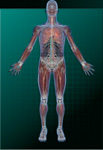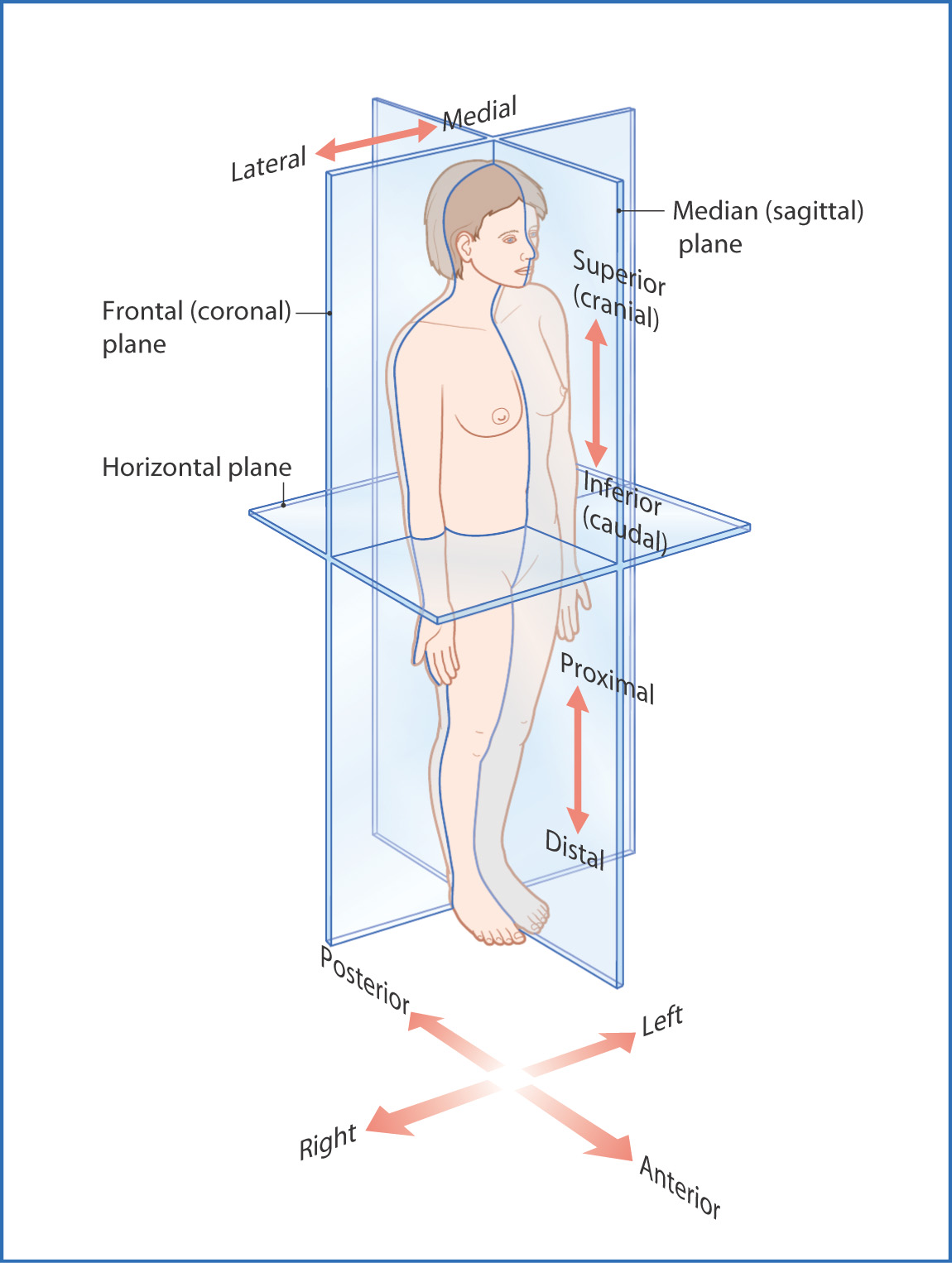
1
Introduction to Anatomy
Anatomy is the study of the structure of the body. Like any other discipline, it has its own language to enable clear and precise communication. Anatomists base all descriptions of the body and its structures on the “anatomical position.” In this position the body is erect, arms at the sides, palms of the hands facing forward, and feet together. The anatomical position is used by anatomists and clinicians as a frame of reference to place anatomy in a three-dimensional context and to standardize the terms for anatomical structures and their functions.
Anatomical planes pass through the body in the anatomical position and are used for reference. The three main descriptive planes (Fig. 1.1) are
- the median plane—a vertical plane that divides the body into left and right halves (strictly speaking, this is called the median sagittal plane)
- sagittal planes—any vertical plane parallel to the median plane, for example, midway between the median plane and the shoulder
- the frontal (or coronal) plane—a vertical plane oriented at 90° to the median plane that divides the body into front (anterior) and back (posterior) sections
- the horizontal (transverse or axial) plane, which divides the body into upper (superior) and lower (inferior) sections and in some situations is referred to as a “cross section”
- sagittal planes—any vertical plane parallel to the median plane, for example, midway between the median plane and the shoulder

FIGURE 1.1 Anatomical planes and orientation.
Specific terms of description and comparison, based on the anatomical position, describe how one part of the body relates to another:
- anterior (ventral)—toward the front of the body
- posterior (dorsal)—toward the back of the body
- superior (cranial)—toward the head
- inferior (caudal)—toward the feet
- medial—toward the midline of the body
- lateral—away from the midline of the body
- proximal—toward the point of origin, root, or attachment of the structure
- distal—away from the point of origin, root, or attachment of the structure
- superficial (external)—toward the surface of the body
- deep (internal)—away from the surface of the body
- dorsum—superior surface of the foot and posterior surface of the hand
- plantar—inferior aspect of the foot
- palmar (volar)—anterior aspect of the hand
- posterior (dorsal)—toward the back of the body
There are also terms for movement. Movements take place at joints, where bone or cartilage articulates. Most movements occur in pairs, with the movements opposing each other:
- Flexion decreases the angle between body parts, and extension increases the angle.
- Adduction is movement toward the median plane of the body, whereas abduction is movement away from the median plane.
- Medial rotation turns the anterior surface medially or inward.
- Lateral rotation turns the anterior surface laterally or outward.
- Supination is lateral rotation of the forearm, for example, such that the palm starts the movement facing down and ends the movement facing up, whereas pronation is medial rotation of the forearm, for example, such that the palm starts the movement facing up and ends the movement facing down.
- Inversion is movement of the foot so that the sole faces medially, and eversion is movement of the foot so that the sole faces laterally.
- Opposition is action whereby the thumb abducts, rotates medially, and flexes so that it can meet the tip of any other flexed finger.
- Circumduction is circular movement of the limbs that combines adduction, abduction, extension, and flexion (e.g., “swinging the arm around in a circle”).
- Elevation lifts or moves a part superiorly, whereas depression lowers or moves a part inferiorly.
- Protrusion (protraction) is to move the jaw anteriorly, and retrusion (retraction) is to move the jaw posteriorly.
- Adduction is movement toward the median plane of the body, whereas abduction is movement away from the median plane.
Structures may be unilateral or bilateral. The heart is an example of a unilateral structure: it exists on only one side of the body. Bilateral structures, such as the vessels of the arm, are present on both (bi-) sides of the body. Two similar adjectives—ipsilateral, meaning on the same side of a structure, and contralateral, meaning on the opposite side—are often used in anatomical descriptions.
Body Systems
A body system is a combination of organs with a similar or related function that work together as a unit. Body systems work together to maintain the functional integrity of the body as a whole.
MUSCULOSKELETAL SYSTEM
Skeleton
The human skeleton of 206 bones comprises
- the axial skeleton—the skull, vertebrae, ribs, sternum, and hyoid bones
- the appendicular skeleton—shoulder girdles with the upper limbs and hip girdles with the lower limbs
Muscles
Muscle cells contract. Movement is produced when the contraction occurs in a muscle that is attached to a rigid structure, such as a bone.
There are three types of muscle that differ in location, histologic appearance, and how they are controlled (voluntary versus involuntary control).

Full access? Get Clinical Tree


